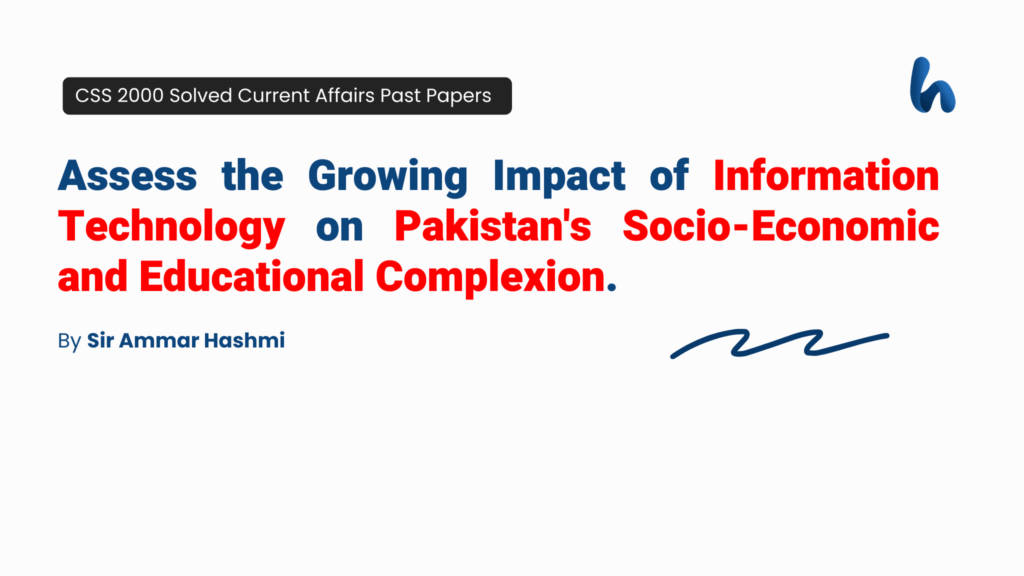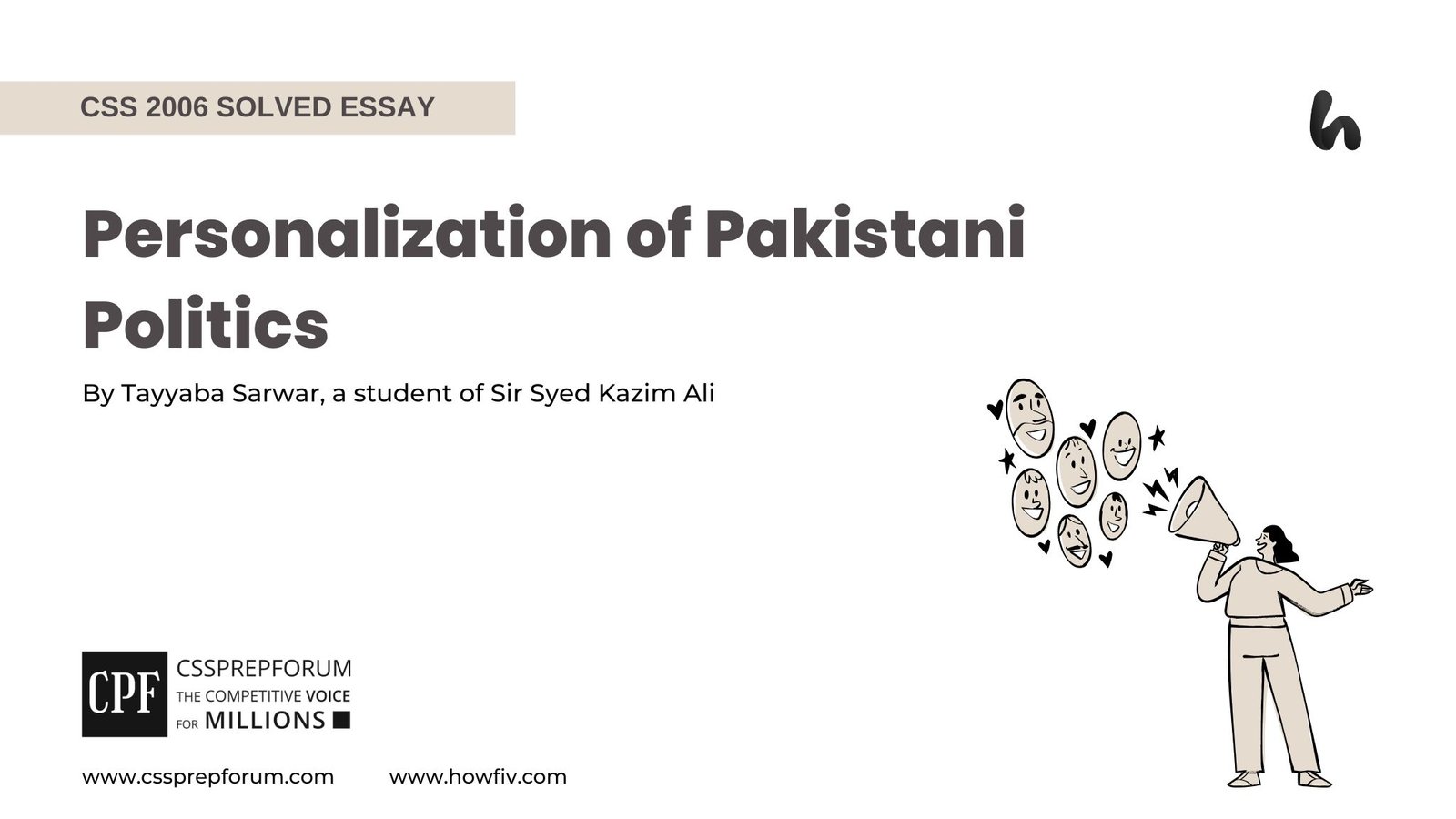CSS 2000 Solved Current Affairs Past Papers | Growing Impact of Information Technology
The following question of CSS Current Affairs 2000 is solved by Sir Ammar Hashmi, the best Current Affairs Coach, on the guided pattern of Sir Syed Kazim Ali, which he taught to his students, scoring the highest marks in compulsory subjects for years. This solved past paper question is uploaded to help aspirants understand how to crack a topic or question, how to write relevantly, what coherence is, and how to include and connect ideas, opinions, and suggestions to score the maximum.

Question Breakdown
In this question, we were asked to assess the growing impact of information technology on Pakistan’s socio-economic and educational complexion.
Outline
1- Introduction
2- Understanding information technology
3- Importance of information technology
4- Current Scenario of Information Technology in Pakistan
5- Impacts of information technology on Pakistan’s socio-economic growth
- ✓Economic Growth through IT Exports
- ✓Opportunities for Entrepreneurship and Innovation
- ✓Enhancement in public services
- ✓Reduction of the digital gap
6- Impacts of information technology on Pakistan’s educational complexion
- ✓Virtual Learning Opportunities
- ✓Curriculum Modernization
- ✓Empowerment of Non-Formal Education
- ✓Promotion of Research and Development
7- Conclusion

Answer to the question
Introduction
Undoubtedly, Information Technology (IT) has emerged as a critical driver of socio-economic growth and educational enhancement in Pakistan, making access to different educational platforms and online trade and marketing possible with a single click. Unlike in the past, IT has revolutionized the lives of millions of Pakistanis in their academic, economic, and social affairs. Among 241 million Pakistanis, 191 million citizens have access to smartphones, indicating a rise of digital literacy in civilians that assists in getting quality education, access to online marketing, and Opportunities for Entrepreneurship and Innovation. Moreover, IT has given pathways to research and development and the transition of traditional industry to high-value digital sectors. Owning to the IT export sector, the nation has witnessed the addition of $3.2 billion to the IT sector, making significant economic growth. To conclude, owning to the initiatives made by the government in the IT sector, IT has significantly contributed to the socio-economic and educational development of the country.
Understanding information technology
Moreover, Information Technology, initially marked in 1958 in an article in the Harvard Business Review, surrounds various technologies and systems that create, store, and transmit different kinds of information. From basic data retrieval to complex systems, information technology involves using hardware, software, networking, and data management to support various educational, economic, and social processes. Historically, IT went in different phases, including the Pre-mechanical phase (3000BC – 1450 AD), Mechanical Phase (1450 – 1840), Electromechanical Phase (1840- 1940), and Electronic Phase (1940 _ present), advancing to computing power storage capacity, and data transmission speeds. Today, IT has advanced and crossed the limits of the human brain and increased its speed and complexity, making mankind highly dependent on IT for local and global operations. In short, IT evolves anything and everything related to computing, communication, data management, and information transmission.
Importance of information technology
Significantly, although IT initially contributed to the arena of business only, it evolved around different fields, including education, social work, agriculture, science and healthcare, playing a central role in the professionalism and career-building of man. In pursuit of this objective, IT grows productivity by atomizing processes that make the operations efficient, analysing data pivotal for decision-making processes, and employing digital platforms for marketing and customer services, which is profound for businesses and economic development. Therefore, modern IT significantly augment operations, data analysis, decision-making processes, and marketing.
Current Scenario of Information Technology in Pakistan
Currently, Pakistan’s IT sector is in a burgeoning trend owing to the efforts and policies made by the government and the increased demands for IT services in Gulf Cooperation Council (GCC) countries, particularly Saudi Arabia. According to data, Pakistan’s IT exports have exceeded $3.2 billion compared to the previous year’s $2.59 billion. Moreover, the IT sector of the country has also witnessed a robust performance of 30 % in the Compound Annual Growth Rate (CAGR), which the government expects and predicts the escalation in exports between $10 billion and 20 billion dollars in the coming few years. However, the IT sector’s potential is threatened due to challenges, including inconsistent government policies, infrastructure deficiencies, and a lack of quality education in the country. To counter that, it is high time that Pakistan met the challenges promptly to pave the path for further development in the IT sector.
Impacts of information technology on Pakistan’s socio-economic growth
Significantly, the IT sector has provided Pakistan with profound socio-economic growth by extending IT exports, enhancing entrepreneurship and innovation, increasing public services, and, most importantly, reducing the digital gap.
- Economic Growth through IT Exports
Initially, the IT sector emerged as a great contributor to the nation’s economic growth. The sector’s IT exports reached nearly $3.5 billion and are projected to grow significantly, expected to generate approximately $6.6 billion in annual exports by 2030 through mobile apps and digital services. This progress strengthens foreign exchange earnings and opens the door for more job opportunities countywide. In 2021, Access Partnership estimated that digital transformation, if leveraged fully, could create up to PKR 9.7 trillion in economic value for Pakistan by 2030. Therefore, the IT sector, through its IT exports, is a pivotal collaborator in the country’s economic development.
- Opportunities for Entrepreneurship and Innovation
Apart from that, the IT sector’s growth is linked with broader economic strategies involved in transitioning from traditional industries to high-value digital sectors. In this regard, the government has established digital parks and incubation centres and fostered a culture of entrepreneurship with numerous tech-driven start-ups, giving way to broader innovation, creativity, and economic value creation. Therefore, information technology paves the road for entrepreneurship and innovation that further leads to the transmission of traditional industries to high-tech industries.
- Enhancement in public services
Moreover, IT has improved public services’ efficiency and effectiveness in Pakistan, giving rise to accountability and transparency. For instance, online portals such as the National Information Technology Board (NITB) provide access to various government services, promoting citizen engagement, public trust, and public awareness. Moreover, IT also promotes emergency services, online healthcare facilities, social care and protection, and multiple trade services. Such initiatives via Information Technology escalate systemization, time management, and economic sparing. Thus, IT has profoundly amplified government services for citizens.
- Reduction of the digital gap
In addition, one of IT’s most significant impacts on society is reducing the digital gap in Pakistani citizens. For example, among the majority of the 241 million people in Pakistan, approximately 191 million are cellular subscribers, indicating a substantial approach to digital technologies. The proliferation of smartphones and internet access has markedly ameliorated digital literacy nationwide. Such online accesses assist people in socialization, online education, banking, etc., developing creativity and fostering economic engagement. Therefore, the IT sector in Pakistan has played a pivotal role in reducing digital division in the country.
Impacts of information technology on Pakistan’s educational complexion
Apart from that, IT has played an instrumental role in Pakistan’s education sector. Its impacts involve virtual learning opportunities, curriculum upgradation, betterment in research and development, and empowerment of non-formal education, leading to literacy growth, creativity, and skilled workforce development.
- Virtual Learning Opportunities
Previously, students had limited access to modern education, being engaged in outdated syllabi, rote learning, and non-technical learning methods in an environment with untrained teachers. Further, students in remote areas faced challenges in achieving quality education and pursuing their desired goals. But now, IT has given broader access to education. Students can now interact with capable and well-trained teachers, professors, and other students nationwide and worldwide. Through IT, students can enrol and pursue education from international platforms, enhancing their ability, creativity, and talent. Moreover, IT has given educators opportunities to teach in a wider environment apart from their regional and traditional classrooms. Therefore, IT has proved to be the turning point in the education sector.
- Modernization Upgradation
Also, IT has created a pathway for the modernization of educational curricula. Unlike in the past, IT has facilitated digital tools and projects, such as digital boards, pens, and high-quality pictures, along with learning applications and platforms to enhance learning quality in Pakistan. Educational institutions in the country are now adopting e-learning techniques and teaching methodologies for better outcomes. Thus, this method has made teaching quality more effective and efficient, assisting students to learn in their comfort zones.
- Empowerment of Non-Formal Education
Additionally, IT has provided pathways for empowering non-formal education for adults seeking skill development. By supporting non-formal education, IT is pivotal in giving education opportunities to non-educated or dropped-out persons to adopt digital skills, online marketing, and data management abilities, strengthening the digitally skilled workforce and leading to long-term economic growth. Therefore, by empowering non-formal education, IT has given way to skill development and workforce growth.
- Promotion of Research and Development
Finally, IT has simplified research and development for institutions by creating virtual environments. To elaborate, IT has given access to advanced digital tools for data collection, analysis, and storage, promoted communicational technologies, such as video conferences and collaborated platforms like Microsoft Teams, and facilitated access to a vast and organized set of demanded information, databases, and patents. Therefore, IT has played a fundamental role in creating an uncomplicated environment for Research and Development.
Conclusion
In a nutshell, as information technology continues to advance, it plays a pivotal role in Pakistan’s socio-economic and educational development, enabling significant services for Pakistani citizens. Currently, the IT sector of the country has witnessed a robust performance of 30 % in Compound Annual Growth Rate (CAGR), which the government expects and predicts the escalation in exports between $10 billion and 20 billion dollars in the coming years. Furthermore, this progress has profoundly impacted civilians’ socioeconomic and educational conditions by enhancing economic growth through IT exports, providing opportunities for entrepreneurship and innovation, reducing the digital gap, strengthening virtual learning, modernizing curriculum, and promoting research and development. In summary, IT has been instrumental in the country’s socioeconomic and educational progress. d overall human welfare, thereby addressing underlying socio-economic issues contributing to instability. Therefore, a multifaceted approach involving diplomatic engagement, economic cooperation, and strategic arms reduction is essential for achieving sustainable peace and prosperity in South Asia.

CSS Solved Past Papers’ Essays
Looking for the last ten years of CSS and PMS Solved Essays and want to know how Sir Kazim’s students write and score the highest marks in the essays’ papers? Then, click on the CSS Solved Essays to start reading them.
CSS Solved Essays
CSS Solved General Science & Ability Past Papers
Want to read the last ten years’ General Science & Ability Solved Past Papers to learn how to attempt them and to score high? Let’s click on the link below to read them all freely. All past papers have been solved by Pakistan’s top CSS GSA coach having the highest score of their students.
General Science & Ability Solved Past Papers












